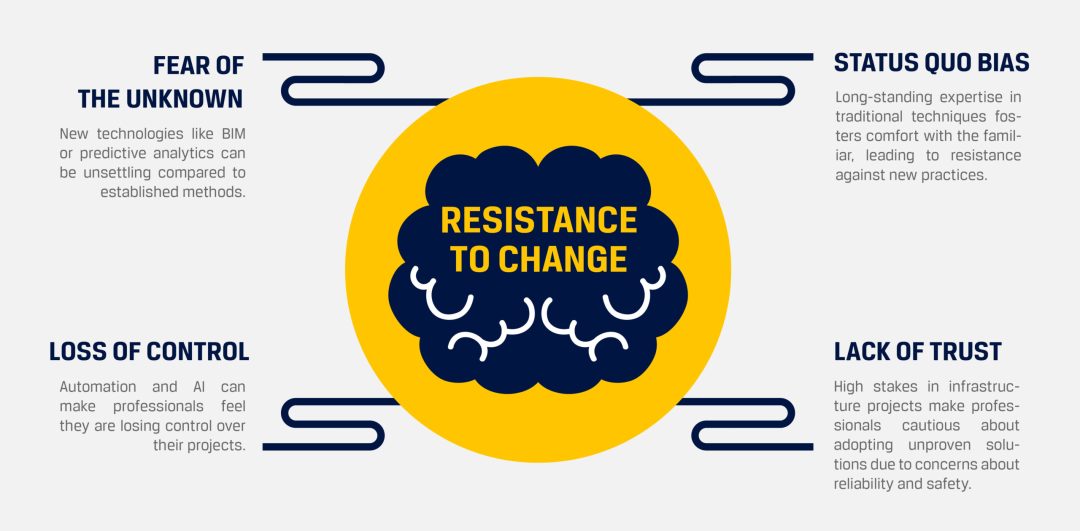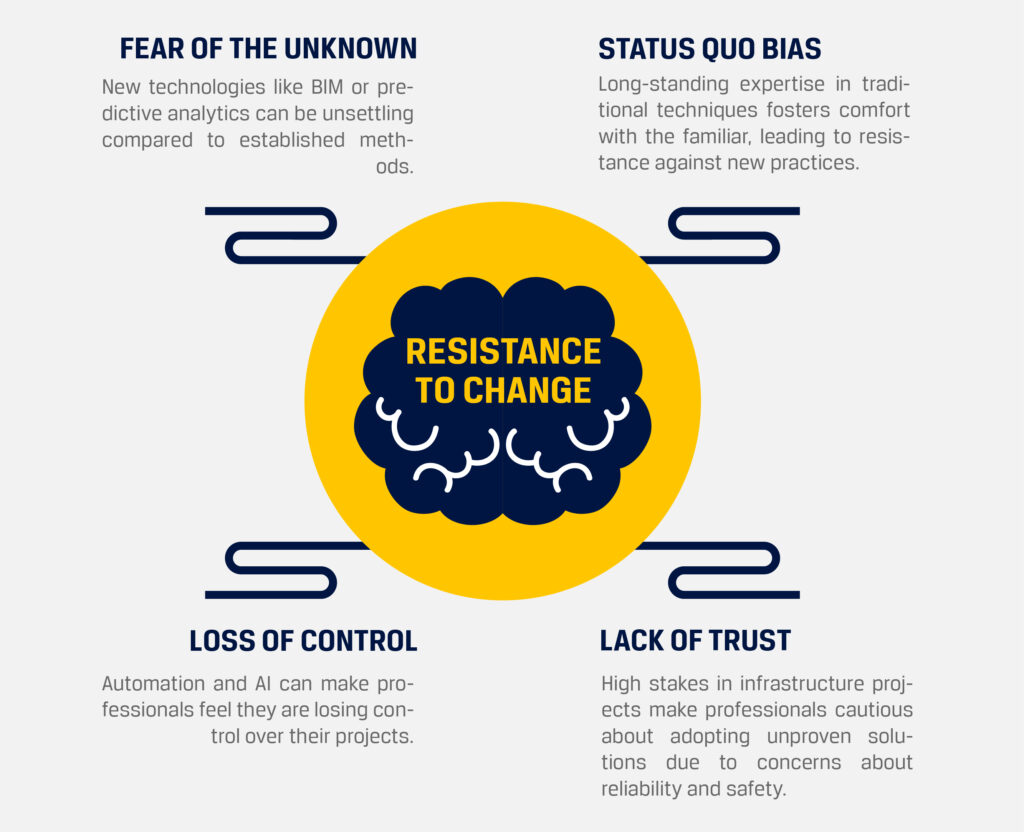Infrastructure professionals often resist adopting new methods or technologies due to psychological barriers:

- Fear of the Unknown: New technologies like BIM or predictive analytics can be unsettling compared to established methods.
- Loss of Control: Automation and AI can make professionals feel they are losing control over their projects.
- Status Quo Bias: Long-standing expertise in traditional techniques fosters comfort with the familiar, leading to resistance against new practices.
- Lack of Trust: High stakes in infrastructure projects make professionals cautious about adopting unproven solutions due to concerns about reliability and safety.
Case Study 1: Introduction of Precast Technology in India’s Housing Projects

Challenge: In India, the adoption of precast technology for mass housing projects faced significant resistance, particularly from contractors and engineers who were used to traditional brick-and-mortar construction methods. Precast offered faster construction times and reduced labor costs, but it required specialized equipment and a shift in project workflows.
Psychological Insight: The resistance stemmed from the fear of the unknown and status quo bias. Professionals had decades of experience in conventional methods and were hesitant to trust a system they hadn’t worked with extensively. There were also concerns about the quality and long-term durability of the precast structures.
Strategy: To counter this, the Delhi Development Authority (DDA) and private builders introduced small pilot projects to demonstrate the technology’s benefits. Training programs were organized to familiarize engineers and workers with precast techniques. The success of these projects gradually shifted perceptions, and precast technology is now being widely adopted in urban housing schemes.
Case Study 2: Smart Cities Mission in India – Resistance to IoT Integration
Challenge: India’s ambitious Smart Cities Mission, which aimed to integrate Internet of Things (IoT) and AI into urban infrastructure, faced resistance from municipal engineers and city planners. The primary concern was around the reliability of these technologies and the fear that automating infrastructure management (such as waste management, traffic monitoring, and smart grids) could lead to job losses or create technical challenges.
Psychological Insight: This resistance was driven by loss of control and lack of trust. Professionals felt that relying on IoT and AI systems might reduce their influence over infrastructure operations and maintenance. There were also concerns about data security and the ability of these technologies to function in India’s diverse urban environments.

Strategy: The government adopted a phased approach to implementing smart infrastructure, starting with cities like Pune and Ahmedabad. They engaged professionals early in the decision-making process, offering workshops and demonstrations of IoT solutions. This reduced apprehension and allowed professionals to see how these technologies could complement their expertise rather than replace it. Local engineers were trained to monitor and troubleshoot these systems, creating a sense of control over the technology.
Case Study 3: Adoption of Green Building Codes in India

Challenge: The introduction of green building codes, such as the Energy Conservation Building Code (ECBC) and the Indian Green Building Council (IGBC) standards, faced pushback from engineers and developers. They perceived sustainable building materials and designs to be more expensive and doubted their performance in extreme Indian climates. This resistance slowed the uptake of energy-efficient construction practices, despite the long-term benefits.
Psychological Insight: The reluctance was primarily due to status quo bias and lack of trust. Professionals were accustomed to using conventional materials like concrete and steel, and they questioned whether eco-friendly materials like bamboo composites or recycled concrete could meet India’s infrastructural demands.
Strategy: To address this, the government incentivized green building certifications through tax benefits and fast-tracked approvals for projects adhering to green standards. Additionally, successful pilot projects like the CII-Sohrabji Godrej Green Business Centre in Hyderabad, which demonstrated the viability of green materials and designs in extreme climates, helped build trust in the new standards. This shifted attitudes towards adopting sustainable practices in commercial and residential construction.
Conclusion
Resistance to change in infrastructure development often stems from fear of the unknown, loss of control, status quo bias, and lack of trust. Case studies highlight how these barriers can be addressed:
- Precast Technology: Overcame resistance through pilot projects and training, demonstrating benefits and shifting perceptions.
- Smart Cities Mission: Eased skepticism about IoT by involving professionals early and providing hands-on experience.
- Green Building Codes: Built trust in sustainable practices through incentives and successful pilot projects.
Involving stakeholders early in the process helps mitigate resistance and fosters a sense of ownership. Addressing psychological barriers with strategies like education, phased implementation, and stakeholder engagement can smooth the path for innovation, leading to more effective and adaptive infrastructure practices.

